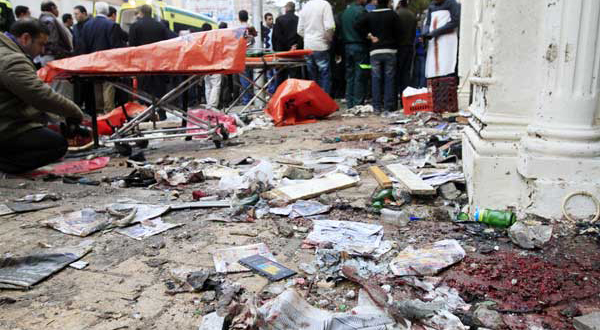 CAIRO: A suspected suicide bomber who killed 23 people outside a church probably intended to set off the explosives inside so as to kill as many people as possible, Egyptian investigators said on Monday.
CAIRO: A suspected suicide bomber who killed 23 people outside a church probably intended to set off the explosives inside so as to kill as many people as possible, Egyptian investigators said on Monday.
The main lead in the investigation into the New Year's Day attack in Alexandria, which no one has claimed, was a severed head found at the scene they said probably belonged to the bomber.
Police also believe that a severed foot, which the blast had thrown over the roof of a mosque across the street from the church, also belonged to the suspected attacker, who they said was a man in his thirties.
Officials suspect the bomber planned to enter the church, which was holding a New Year's Eve mass, but was blocked by police guards at its gates.
He then set off an explosives belt packed with between 10 and 15 kilograms (22-33 pounds) of TNT, bolts and ball bearings as the congregants emerged shortly after midnight.
Police also found a still-unidentified hand amputated by the powerful blast, which overturned a car and damaged the church's facade.
Surgeons have been called in to try to reconstruct the head's features to determine its identity.
The attack was Egypt's worst since one on a Sinai tourist resort in 2006.
It came two months after the Islamic State of Iraq, the Al-Qaeda affiliate in Iraq, attacked a Syriac Catholic church in Baghdad. It said its objective was to force the release of two Coptic priests' wives in Egypt it claimed had converted to Islam and were being held against their will.
An Al-Qaeda-linked website then published a list of Egyptian and European Coptic churches it said should be attacked, including the churches targetted in the bombing.
Saturday's bombing was a sharp departure from typical sectarian incidents in the Muslim-dominated country.
The government immediately blamed foreign involvement in the bombing, although it did not say how it reached that conclusion.
Analysts, who often dismiss government claims of foreign involvement, said the timing and execution of the attack may suggest an Al-Qaeda-inspired cell.
"This resembles attacks we see outside the country. It has the features of Al-Qaeda," said Diaa Rashwan, an expert on Islamist movements with the Ahram Center for Political and Strategic Studies.
The country saw a resurgence of attacks in the past decade, including a series of bombings at Sinai tourist resorts between 2004 and 2006.
In the past two years it says it has uncovered two separate cells of Al-Qaeda loyalists accused of a primitive bombing in 2009 that killed a French teenager and of plotting attacks against tourists and shipping in the Suez Canal.
Many have since been released for a lack of evidence, while others are facing trial.



